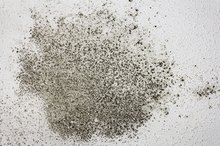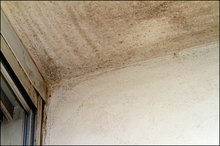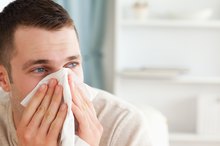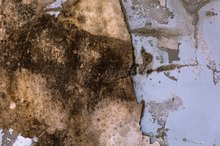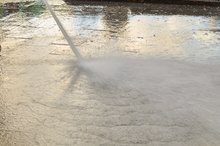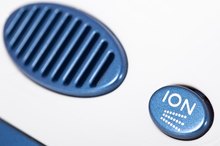What does fact checked mean?
At Healthfully, we strive to deliver objective content that is accurate and up-to-date. Our team periodically reviews articles in order to ensure content quality. The sources cited below consist of evidence from peer-reviewed journals, prominent medical organizations, academic associations, and government data.
The information contained on this site is for informational purposes only, and should not be used as a substitute for the advice of a professional health care provider. Please check with the appropriate physician regarding health questions and concerns. Although we strive to deliver accurate and up-to-date information, no guarantee to that effect is made.
The Effects of Black Mold on Infants
According to a study by the Mayo Clinic in 1999, nearly all chronic sinus infections are the result of mold 2. Mold is a tenacious substance that takes root in the presence of moisture. According to the Centers for Disease Control, "There is always a little mold everywhere -- in the air and on many surfaces." If you have mold in your home, your respiratory health and that of any small children or infants might be at risk.
If you are experiencing serious medical symptoms, seek emergency treatment immediately.
Black Mold
Molds themselves aren't toxic. Instead, certain toxigenic molds produce toxins (specifically, mycotoxins). However, these molds aren't any more hazardous than other common molds which can grow indoors, according to the CDC. Stachybotrys atra, or black mold, is toxigenic. It's greenish-black and can grow on material with a high cellulose and low nitrogen content, including fiberboard, paper and dust. Black mold thrives on moisture and needs it constantly in order to grow.
- Molds themselves aren't toxic.
- It's greenish-black and can grow on material with a high cellulose and low nitrogen content, including fiberboard, paper and dust.
Pulmonary Hemosiderosis
Diseases Linked to Black Mold
Learn More
Pulmonary hemosiderosis is the medical term for the bleeding of the lungs of infants, which a few studies have linked black mold exposure. The disorder requires immediate medical attention. But don't panic just yet -- the CDC asserts that reports linking pulmonary hemosiderosis to black mold are rare and haven't proven that there's a causal relationship. "To date, a possible association between acute idiopathic pulmonary hemorrhage among infants and Stachybotrys chartarum (Stachybotrys atra) has not been proved," the CDC reports. "Further studies are needed to determine what causes idiopathic hemorrhage."
- Pulmonary hemosiderosis is the medical term for the bleeding of the lungs of infants, which a few studies have linked black mold exposure.
- But don't panic just yet -- the CDC asserts that reports linking pulmonary hemosiderosis to black mold are rare and haven't proven that there's a causal relationship. "
Common Effects of Mold
Furthermore, indoor exposure to molds can exasperate asthma symptoms. Another study linked molds to the development in asthma in children, "particularly children who may be genetically susceptible to asthma development," although more research is needed. Severe reactions, such as fever and shortness of breath, may occur for workers who are exposed to large amounts of mold. People with allergies, immune suppression disease or underlying lung disease may be more susceptible to respiratory problems caused by mold.
- Furthermore, indoor exposure to molds can exasperate asthma symptoms.
- Severe reactions, such as fever and shortness of breath, may occur for workers who are exposed to large amounts of mold.
Prevention and Solution
Diseases Caused by Black Toxic Mold
Learn More
According to the CDC's Healthy Housing Assessment Manual, the most important way to prevent mold growth is to control moisture. The CDC recommends indoor humidity to be between 40 percent and 60 percent. Fix all leaks, check all ventilation, use exhaust fans, limit the amount of indoor plants and use dehumidifiers to keep moisture out of your house. Nonporous materials can be cleaned with solutions of one cup of bleach in one gallon of water. However, carpets, fabrics and books exposed to mold will likely have to be removed. If you have persistent symptoms, visit a health care provider.
- According to the CDC's Healthy Housing Assessment Manual, the most important way to prevent mold growth is to control moisture.
- Fix all leaks, check all ventilation, use exhaust fans, limit the amount of indoor plants and use dehumidifiers to keep moisture out of your house.
What Do YOU Think?
Did you know that black mold isn't any more harmful than other molds? How do you usually deal with mold in your household? Has mold every affected your health? Let us know in the comments section!
- Did you know that black mold isn't any more harmful than other molds?
- How do you usually deal with mold in your household?
Related Articles
References
- Toxic Black Mold Information Center: Mold Health Effects
- Science Daily: 1999 Mayo Clinic Study
- Centers for Disease Control of Prevention: Facts about Stachybotrys Chartarum and Other Molds
- "Allergy and Asthma Proceedings"; Stachybotrys chartarum (chartarum = atra = alternans) and other problems caused by allergenic fungi; JA Chapman; January 2003
- "Mycopathalogia"; Histological, Immunohistochemical and Morphometric Changes in Lung Tissue in Juvenile Mice Experimentally Exposed to Stachybotrys Chartarum Spores; TG Rand et al; 2003
- Indoor Environmental Asthma Triggers. Environmental Protection Agency.
- National Heart, Lung, and Blood Institute. Expert Panel Report 3 (EPR3): Guidelines for the Diagnosis and Management of Asthma
Writer Bio
Christy Callahan has been researching and writing in the integrative health care field for over five years, focusing on neuro-endocrinology. She has a Bachelor of Science degree in biology, earned credits toward a licensure in traditional Chinese medicine and is a certified Pilates and sport yoga instructor.
